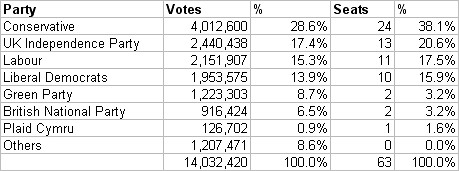I've been crunching some numbers on the UK's European Parliament election results. And despite the system they use supposedly being "proportional", they show significant disproportionalities. Here's the results sans Scotland, which won't be out till tomorrow:

The reason for this unfairness is because for these elections the UK chops itself into 12 districts (9 regions plus Scotland, Wales and Northern Ireland) of between 3 and 10 seats, and applies the D'Hondt method within each one. This effectively introduces a large threshold (upwards of 10%) within each region, and allocates the "rounding error" to the larger parties 9as D'Hondt favours them). Which adds up on a national scale to the sorts of disproportionality seen above.
The EU's rules for how member states run elections are pretty simple, and require only three things:
The level of disproportionality caused by subdivision in the above results means that the UK fails to meet these basic criteria. It should reform the electoral system it uses immediately, either to do away with districting, or to introduce a Swedish-style national topup.





